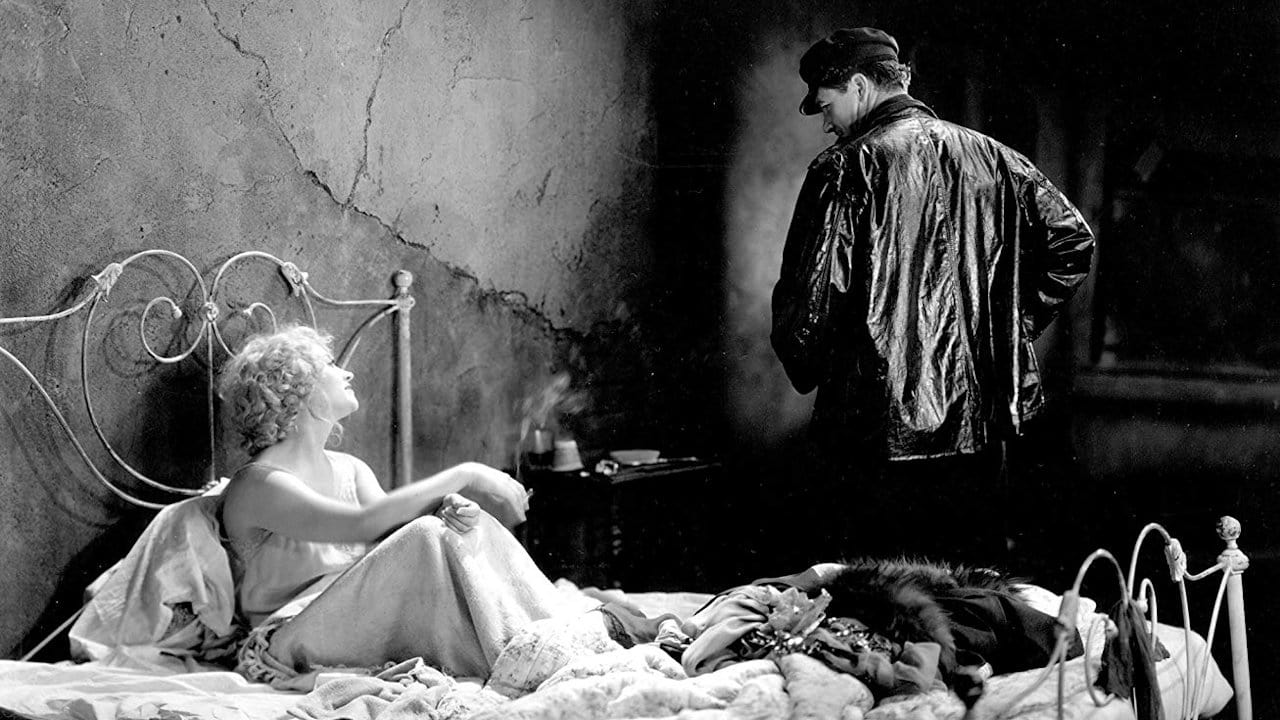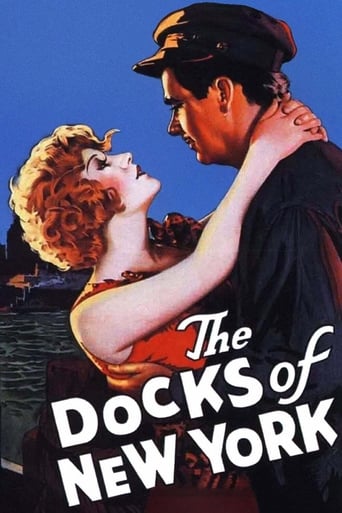

Docks of New York (1928) is a prime example of the power of silent film at its height. After 1928, the medium would be crushed underneath the rise of sound technology, which was a shame considering how technically dazzling and sophisticated they had become by the latter half of the 1920s.The film is a character study of a rough stoker and a suicidal woman. The two fall in love after he rescues her from an attempt to take her own life, though there is a chance they may be separated by the stoker's aversion to commitment and responsibility. The characters are all flawed, compelling people, each one brought to life with subtle performances from the leading actors. The atmosphere is appropriately seedy and dark, with chiaroscuro lighting and crowded spaces. It's a slow film, one that will not please those who prefer more plot or action, but it is worth your time, showcasing silent cinema at its loftiest heights. It is films like Docks of New York which make one wish the silent era had lingered on a little while longer.
... View MoreWith one night in town while the ship is at port, we follow our lead stoker into a world of bars, brutes, brawls and bawdiness, where the only objective is to have a good time, all else be damned, which you get the sense has happened many times before, at many cities around the world, whenever they get a night at port. When a young woman attempts suicide by jumping into the water, our stoker dives in to save her, and thus begins a very unromantic love tale. Being who he is, this is seen only as an opportunity to bed her, and being promiscuous herself, she is only too happy to go along with it.In a strange twist that doesn't make a lot of sense, they decide to get married then and there in the bar, and lo and behold, a paster just happens to be in the vicinity, and lo and behold, he just happens to agree to the ceremony, despite being opposed to the idea, and despite their not having the license! Apparently everyone considers this a great deal of fun - well, I guess they're all drunk!The next day we are supposed to get the idea the two of them have changed their ways, and this hasty, illegal, drunken marriage was actually the best thing for them. He leaves her to get back on the ship, before suddenly deciding the stoking life is not for him anymore, and swims back to shore. In the meantime she has been arrested for the possession of clothes he stole for her, but is saved by his reappearance and admittance of guilt, and they are for sure going to live happily ever after, just as soon as he's served his stint in jail.Poor as the story is, I still highly recommend 'The Docks of New York' on account of the first 30 odd minutes, by which point the plot hasn't yet completely disintegrated, and are some of the most beautiful put to film. The fire steamed boat, the smokey bar and the misty dock create a wonderfully hazy atmosphere, seducing us into this messy world far more convincingly than the characters seduce each other. If only they had ended it then, it would have been a classic.
... View MoreInitially it was very easy to forget you were watching a narrative film and to just imagine it was a documentary maker's homage to the seedier docklands of New York. Down in the ship's boiler room - George Bancroft and Clyde Cook didn't seem like actors, they actually looked like stokers, dreaming of going ashore. And the eerie silhouette of the girl on the pier - then the splash!! I really think that "The Docks of New York" is a triumph of von Sternberg's visual artistry. Mists and shadows, especially compelling was the scene when Bancroft carried the bedraggled Compson along the waterfront to her shabby room.Just as he had given Evelyn Brent's career a new lease of life, von Sternberg proceeded to do the same thing for Betty Compson. Although "The Docks of New York" was advertised as her comeback picture, according to Betty, she had never been away. In a chapter devoted to her in "From Hollywood" by DeWitt Bodeen, he chronicles her ups and downs of the twenties. She divorced her husband, director James Cruze, and was immediately besieged by creditors (to do with his bankruptcy). She then realised most of the major studios thought she was a has been but instead of taking it to heart, she went over to Chadwick, a poverty row studio and worked so hard she got back into shape and once again had the big studios bidding for her services. Another actor von Sternberg rescued was George Bancroft, who spent most of the 20s as a Western badman albeit with a hearty laugh. First casting him as the charismatic gangster in "Underworld" then as the burly stoker, Bill Roberts, in "The Docks of New York". Bancroft was larger than life!!!The story is simple, Roberts rescues a prostitute after she has thrown herself in the river. Initially hoping to paint the town red before departing the next morning, he takes a shine to Mae's vulnerableness and convinces her a good time is better than a watery grave. After carousing at the dockside tavern Bill gets carried away and proposes to Mae and after much coaxing she accepts - but she is serious as is the parson "Hymn Book Harry" (Gustav Von Seyffertitz) whose withering look upon those assembled tells you just what he thinks of them. Come the morning Bill is preparing to leave, treating the whole thing as a joke, but back on the ship......The music is wonderful with an orchestral score that has a real feel for the gritty reality of the docks - it also incorporates popular songs of the day "A Bird in a Gilded Cage", "The Sidewalks of New York" etc. I should have realised it was the brilliant Robert Israel, my favourite composer of silent film scores.Making just as much of a dazzling impression is Baclanova as a distinctly unglamorous waterside worker. She is married to Bill's brutish boss, but tells Mae "I was decent too - until I got married"!!!
... View MoreOne of the less obvious differences between sound and silent pictures, is that whereas in a sound picture the director will set up a scene, prep the actors and then call action, in a silent the director could (and usually would) continue to direct even while the cameras were rolling. Of course it's hard to tell how much this difference affected the finished product in real terms. However, with a director like Joseph "von" Sternberg, who demanded a complete (and indeed tyrannical) control over every aspect of the image, the ability to carry on shouting at his cast and crew right through the take was probably a considerable bonus in fine-tuning his elaborate visual style.With Docks of New York being a late silent, it has more or less as much fluidity of movement and camera angle as your average sound flick. However there is an extreme complexity in the movement of a kind that you only really saw in Sternberg's silents. Take for example those lengthy dolly shots through the bar, with extras moving across the shot as the camera goes in or out. Those movements across the screen look haphazard, but they are carefully timed to complement the camera movement and give a rising tide of franticness. To arrange everyone so precisely there must have been almost as much activity behind the camera as in front of it. You could do a shot like that in a talkie, but it would require copious reheasing, and I don't think that's something they tended to bother with in the early sound era, what with the all the other obstacles they had to overcome. It's certainly true that Sternberg used to spend most of his set-up time sorting out the lighting schemes, rather than giving any detailed priming to his cast.Sternberg's layered patterns of movement not only add to the aesthetic quality of this picture, but they enhance its atmosphere. The barroom scenes in particular have a spectacularly chaotic feel to them. The fact that every edge of the room is filled by a mass of moving bodies makes it impossible to figure out the size and layout of the place. But for all his visual lavishness, Sternberg himself admitted to caring little about stories, and as a result the narrative gets a little lost amidst all the shadows. This is even given the fact that Docks of New York is overburdened by intertitles.Sternberg had also yet to fully develop his stylised and dappled lighting patterns that can be seen in his talkies. Here that's a good thing, because it means his camera shows the actors up a little better. And there are some fine performances here worth capturing. George Bancroft gives a superbly realist turn, looking every inch the rough but basically good-hearted stoker. Betty Compson is also nicely subtle, in a slow and measured performance with plenty of under-the-surface emoting. An honourable mention should go to Clyde Cook, who plays Bancroft's buddy Steve. Cook was an Australian slapstick comic, once the star of his own shorts but by this time doing supporting work in features. He is perhaps a little too clownish for the sombre tone of Docks of New York, but entertaining to watch and capable of a spot of straight acting when the occasion demands.The oevre of Herr Sternberg can generally be summed up as pretty to look at but dramatically unengaging. As a silent picture, where the director can put his all into the image without having to worry about the business of dialogue, Docks of New York is just that little bit prettier to look at. And yet as one lacking in a strong narrative drive it is also that little bit more dramatically unengaging. It's a shame, because this is potentially one of the most poignant tales he ever dealt with. Bancroft and Compson recognise this, and play it appropriately, but the director remains a hard-boiled cynic who knows a few camera tricks.
... View More